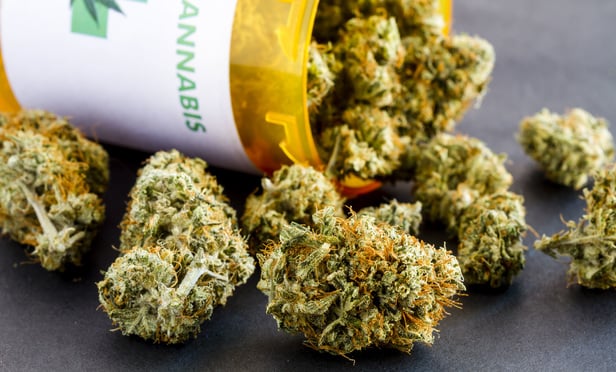Medical Marijuana Business Banking Remains Difficult, Lawyers Say
The banking industry is a major hurdle for the medical marijuana business in New York and other states, lawyers say. Big banks are reluctant to get involved because of the uncertainty around federal anti-money laundering and other statutes aimed at discouraging moving illegal cash around.
March 14, 2018 at 05:08 PM
4 minute read

ALBANY — While states have been in the forefront of legal marijuana expansion, the banking industry in New York and elsewhere is still shy about collecting revenue from a Schedule I substance that's still illegal at the federal level.
Banking is a major hurdle for the legal medical marijuana business, lawyers say. Big banks are reluctant to get involved because of the uncertainty around federal anti-money laundering and other statutes aimed at discouraging moving illegal cash around.
Seth Goldberg, a partner at Duane Morris in Philadelphia whose practice encompasses health care, pharmaceuticals and cannabis/hemp, told the New York Law Journal recently that the “banking problem has depressed the growth” of medical marijuana in the United States, including California.
“It creates real concerns that businesses in other industries do not face, such as having to operate in cash [and] restricted access to capital,” Goldberg said, noting that legal medical marijuana companies have limited access to commercial, small business and construction loans and no daily banking services.
Because big banks are fearful of repercussions surrounding collecting revenue from an activity that is still illegal at the federal level, smaller state banks and credit unions have operated in that void. In New York, some of the companies that grow and sell medical marijuana are using state banks to house their revenue, according to people familiar with the operation, but they wouldn't disclose which institutions they are using.
Banking in the legal marijuana sphere was largely made possible by the Obama administration, which in 2014 issued guidelines telling banks that they would not be punished if they provided services to legitimate marijuana businesses in states that have legalized the drug for medical or recreational use. The guidelines issued by the Financial Crimes Enforcement Network, an office within the U.S. Treasury Department, require that banks monitor their customers who are in the legal marijuana business. Though it does not grant banks immunity, it directs prosecutors to go after institutions who are not following the reporting requirements.
While banking for the legal marijuana industry has been uncertain, it was further complicated in January when Attorney General Jeff Sessions rescinded the so-called Cole memo, an Obama-era policy that generally kept federal law enforcement from interfering with states' marijuana sales. The rescission of the Obama-era directive has raised questions as to whether the FinCen guidance will remain in place, said Goldberg.
“The FinCen guidance is still in place, but there is confusion given its intertwinement with the Cole [memo],” Goldberg said in an interview. “The risks and heavy reporting requirements on banks has caused very few banks to openly accept [marijuana-related business] funds.”
The FinCen did not immediately answer questions when asked what the current status of the guidelines were and whether there are plans to keep them in place.
For banks and credit unions who want to operate in the marijuana space, it's a prohibitively expensive process, according to Andrew Sacks, a managing partner and head of the cannabis and hemp department at Pennsylvania-based Sacks Weston Diamond. Banks have to hire auditors to make sure that revenues from marijuana companies are kept separate and that software is available for marijuana-related transactions, Sacks said.
As a result of the limitations, only roughly 400 banks and credit unions nationally serve legal marijuana companies, according to Sacks and other official estimates. That's just a fraction of the approximately 5,000 commercial FDIC banks.
Despite the restrictions, the legal marijuana industry has flourished in states such as Colorado, which received $247 million in tax and fee revenue from legal marijuana last year, according to its revenue department.
In New York, where medical marijuana became legal in 2014, the state's program failed to gain traction in its nascent years. But the updated financial plan released by the state's Division of the Budget shows that New York now projects $2 million in annual revenue from the 7 percent excise tax on medical marijuana sales. That figure is up from the $1 million revenue projection the state had anticipated through the 2022 fiscal year.
The New York Department of Taxation and Finance collected $1.24 million in the first nine months of the current fiscal year, which began in April 2017, meaning that the five companies authorized to grow and sell the drug in New York made sales of roughly $17.7 million.
This content has been archived. It is available through our partners, LexisNexis® and Bloomberg Law.
To view this content, please continue to their sites.
Not a Lexis Subscriber?
Subscribe Now
Not a Bloomberg Law Subscriber?
Subscribe Now
NOT FOR REPRINT
© 2025 ALM Global, LLC, All Rights Reserved. Request academic re-use from www.copyright.com. All other uses, submit a request to [email protected]. For more information visit Asset & Logo Licensing.
You Might Like
View All


Prosecutors Ask Judge to Question Charlie Javice Lawyer Over Alleged Conflict
Trending Stories
Who Got The Work
J. Brugh Lower of Gibbons has entered an appearance for industrial equipment supplier Devco Corporation in a pending trademark infringement lawsuit. The suit, accusing the defendant of selling knock-off Graco products, was filed Dec. 18 in New Jersey District Court by Rivkin Radler on behalf of Graco Inc. and Graco Minnesota. The case, assigned to U.S. District Judge Zahid N. Quraishi, is 3:24-cv-11294, Graco Inc. et al v. Devco Corporation.
Who Got The Work
Rebecca Maller-Stein and Kent A. Yalowitz of Arnold & Porter Kaye Scholer have entered their appearances for Hanaco Venture Capital and its executives, Lior Prosor and David Frankel, in a pending securities lawsuit. The action, filed on Dec. 24 in New York Southern District Court by Zell, Aron & Co. on behalf of Goldeneye Advisors, accuses the defendants of negligently and fraudulently managing the plaintiff's $1 million investment. The case, assigned to U.S. District Judge Vernon S. Broderick, is 1:24-cv-09918, Goldeneye Advisors, LLC v. Hanaco Venture Capital, Ltd. et al.
Who Got The Work
Attorneys from A&O Shearman has stepped in as defense counsel for Toronto-Dominion Bank and other defendants in a pending securities class action. The suit, filed Dec. 11 in New York Southern District Court by Bleichmar Fonti & Auld, accuses the defendants of concealing the bank's 'pervasive' deficiencies in regards to its compliance with the Bank Secrecy Act and the quality of its anti-money laundering controls. The case, assigned to U.S. District Judge Arun Subramanian, is 1:24-cv-09445, Gonzalez v. The Toronto-Dominion Bank et al.
Who Got The Work
Crown Castle International, a Pennsylvania company providing shared communications infrastructure, has turned to Luke D. Wolf of Gordon Rees Scully Mansukhani to fend off a pending breach-of-contract lawsuit. The court action, filed Nov. 25 in Michigan Eastern District Court by Hooper Hathaway PC on behalf of The Town Residences LLC, accuses Crown Castle of failing to transfer approximately $30,000 in utility payments from T-Mobile in breach of a roof-top lease and assignment agreement. The case, assigned to U.S. District Judge Susan K. Declercq, is 2:24-cv-13131, The Town Residences LLC v. T-Mobile US, Inc. et al.
Who Got The Work
Wilfred P. Coronato and Daniel M. Schwartz of McCarter & English have stepped in as defense counsel to Electrolux Home Products Inc. in a pending product liability lawsuit. The court action, filed Nov. 26 in New York Eastern District Court by Poulos Lopiccolo PC and Nagel Rice LLP on behalf of David Stern, alleges that the defendant's refrigerators’ drawers and shelving repeatedly break and fall apart within months after purchase. The case, assigned to U.S. District Judge Joan M. Azrack, is 2:24-cv-08204, Stern v. Electrolux Home Products, Inc.
Featured Firms
Law Offices of Gary Martin Hays & Associates, P.C.
(470) 294-1674
Law Offices of Mark E. Salomone
(857) 444-6468
Smith & Hassler
(713) 739-1250







